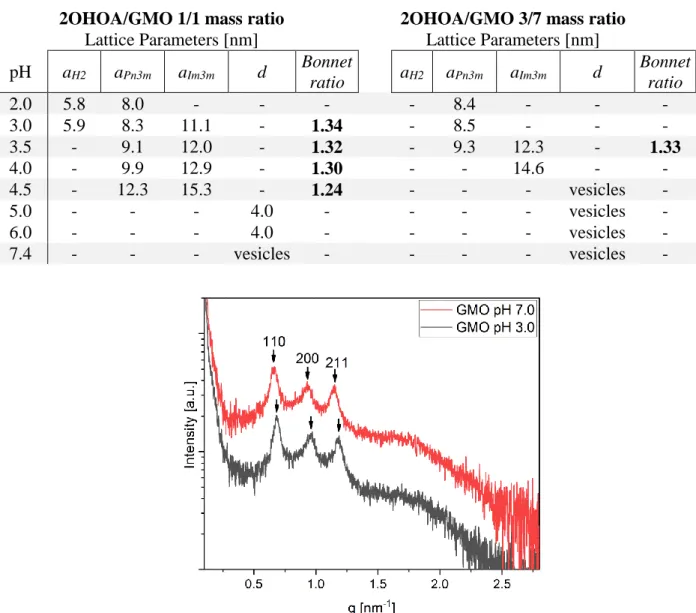S-1 Supporting Information
pH-Responsive Nano-Self-Assemblies of the Anticancer Drug 2-Hydroxyoleic Acid
Rama Prajapati†§, Mark Gontsarik‡§, Anan Yaghmur†*, Stefan Salentinig ┴‡*
†Department of Pharmacy, Faculty of Health and Medical Sciences, University of
Copenha-gen, Universitetsparken 2, DK-2100 Copenhagen Ø, Denmark
‡
Laboratory for Biointerfaces, Empa, Swiss Federal Laboratories for Materials Science and Technology, Lerchenfeldstrasse 5, 9014 St. Gallen, Switzerland
┴Department of Chemistry, University of Fribourg, Chemin du Musée 9, 1700 Fribourg,
Swit-zerland
*Corresponding authors:
Stefan Salentinig, e-mail: stefan.salentinig@unifr.ch Anan Yaghmur, e-mail: anan.yaghmur@sund.ku.dk
S-2 Critical Packing Parameter model
The critical packing parameter (CPP) model (Eq. S1) considers the molecular geometries of the participating amphiphilic compounds to describe self-assembled structures, and is ex-pressed as following:1
𝐶𝑃𝑃 = 𝑣 𝑎0 𝑙
(S1)
where v is the effective hydrophobic chain volume, ao is the effective headgroup area at the interface, and l is the length of the hydrophobic tail. The CPP model takes into account the relative contribution of the hydrophobic and hydrophilic moieties of the amphiphilic com-pound in predicting the type of the self-assembled structure: at CPP > 1, inverse (oil-contin-uous) structures will be formed, whereas at CPP ~ 1 and CPP < 1, the compound will tend to form flattened bilayers (a lamellar liquid crystalline structure), and normal (water-contin-uous structures), respectively. 1
SAXS data analysis
The space groups of the corresponding LLC phases were determined by the relative posi-tions of the detected Bragg peaks in the scattering curves, which correspond to the reflecposi-tions from the planes defined by their Miller indices. The lattice parameters of the inverted-type hexagonal H2 phase, 𝑎𝐻2, and of the bicontinuous cubic phases Pn3m, 𝑎𝑃𝑛3𝑚, and Im3m,
𝑎𝐼𝑚3𝑚, the interlamellar distance of the multilamellar vesicles’ (MLVs’) bilayer stacks, d,
was calculated from the q positions of the Bragg reflections using Eq. S2-S4. Lorentzian fit was used to estimate the q- value of Bragg reflections.
𝑎𝐻2 = 4𝜋 𝑞√3√ℎ
S-3 𝑎𝑃𝑛3𝑚/𝐼𝑚3𝑚 =
2𝜋 𝑞 √ℎ
2+ 𝑘2+ 𝑙2 (S3)
where q is the q-value and h, k, and l are the Miller indices of the corresponding Bragg reflections.
𝑑 = 2𝜋ℎ
𝑞ℎ (S4)
where h is the order of the Bragg peak, and qh is the q-value of the h-th order Bragg peak.
Fitting of 𝒑𝑲𝒂𝒂𝒑𝒑 from the ζ –potential measurements
To estimate the apparent pKa of 2OHOA in the 2OHOA/GMO self-assemblies, 𝑝𝐾𝑎𝑎𝑝𝑝,
the ζ –potential values in the pH 2.0-9.0 range, 𝜁𝑝𝐻 using Eq. S5, derived from the Hender-son-Hasselbalch relation2,
𝜁𝑝𝐻 = 𝑍1 + 𝑍1 − 𝑍2
10(𝑝𝐾𝑎𝑎𝑝𝑝−𝑝𝐻)∗𝑝+ 1 (S5)
where the fitting parameters Z1 and Z2 are the bottom and top asymptotes, and p is the hill slope.
S-4 Table S1. Lattice parameters of the identified liquid crystalline phases in samples with 1/1 and 3/7 2OHOA/GMO mass ratio at different pH, calculated using Eq. S2-S4. Bonnet ratio is calculated as the ratio between the lattice parameters of the coexisting Im3m and Pn3m structures and has a theoretical value of 1.279.3 All samples were dispersed in PBS with 2 mg/mL F127.
2OHOA/GMO 1/1 mass ratio 2OHOA/GMO 3/7 mass ratio Lattice Parameters [nm] Lattice Parameters [nm] pH aH2 aPn3m aIm3m d Bonnet ratio aH2 aPn3m aIm3m d Bonnet ratio 2.0 5.8 8.0 - - - - 8.4 - - - 3.0 5.9 8.3 11.1 - 1.34 - 8.5 - - - 3.5 - 9.1 12.0 - 1.32 - 9.3 12.3 - 1.33 4.0 - 9.9 12.9 - 1.30 - - 14.6 - - 4.5 - 12.3 15.3 - 1.24 - - - vesicles - 5.0 - - - 4.0 - - - - vesicles - 6.0 - - - 4.0 - - - - vesicles - 7.4 - - - vesicles - - - - vesicles -
Figure S1. SAXS patterns for the F127-stabilized GMO cubosomes in absence of 2OHOA at pH 3.0 (black) and 7.0 (red), with the calculated Im3m phase lattice parameters of 13.1 and 13.5 nm, respectively. The change in pH from 7.0 to 3.0 resulted only in a very minor decrease in the lattice parameter.
S-5 References
(1) J. N. Israelachvili; Mitchell, D. J.; Ninham, B. W. Theory of Self-Assembly of Hydrocarbon Amphiphiles into Micelles and Bilayers. J. Chem. Soc., Faraday Trans.
2 1976, 72, 1525–1568.
(2) Malhotra, A.; Coupland, J. N. The Effect of Surfactants on the Solubility , Zeta Potential , and Viscosity of Soy Protein Isolates. Food Hydrocoll. 2004, 18, 101– 108.
(3) Hyde, S. T. Bicontinuous Structures in Lyotropic Liquid Crystals and Crystalline Hyperbolic Surfaces. Curr. Opin. Solid State Mater. Sci. 1996, 1, 653–662.
